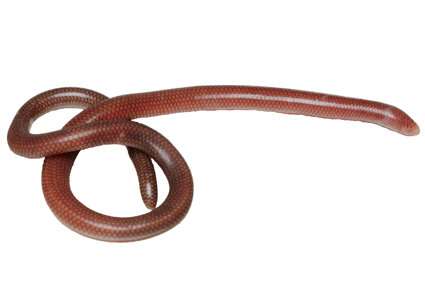This article has been reviewed according to Science X's editorial process and policies. Editors have highlighted the following attributes while ensuring the content's credibility:
fact-checked
peer-reviewed publication
reputable news agency
proofread
'Limbless' creature found digging beneath rotten tree in Vietnam: It's a new species

In Vietnam's driest and hottest region, a limbless forest creature took refuge under a rotten log, scrounging around for termites to eat. Suddenly, something lifted the nearly-blind animal into the air. It tried to defend itself, but to no avail.
Scientists successfully captured the "elusive" animal—and discovered a new species.
Researchers ventured into the dry lowland forest of Nui Chua National Park on three surveys between September 2022 and March 2023, according to a study published Dec. 1 in the journal Zootaxa. They were searching for a type of lizard known as a blind skink.
To locate these lizards, researchers looked for yellow-bellied termites, its favorite food, then searched the surrounding area, one of the study's co-authors, Nikolay Poyarkov, told McClatchy News in an email.
Digging around in the leaves, soil and rotten logs, researchers found seven of these blind skink lizards, the study said. They took a closer look at the animals and realized they'd discovered a new species of lizard: Dibamus tropcentr, or the Ninh Thuận blind skink.
Ninh Thuận blind skinks have a worm-like body that can reach about 4.6 inches in length, the study said. Their eyes are rudimentary and completely covered by scales. They are also "limbless" with only males having rudimentary hind limbs that form flap-like structures near their tails.
It has a pinkish-brown body, lighter-colored near its head and darker-colored near its tail. The skink looks a lot like an earthworm but appears to have a smooth, scaly texture.
Ninh Thuận blind skinks were found during the day while digging, typically near yellow-bellied termites, researchers said.
When picked up or handled, the lizards raised (their) body scales, a defense mechanism that gave them a somewhat wrinkled appearance, researchers said. This behavior mimics a type of worm that is "likely inedible for some potential (skink) predators like birds."
Ninh Thuận blind skinks have been found at two sites in Nui Chua National Park, the study said. This national park is in Ninh Thuận province, the "driest and hottest" part of Vietnam, and about 200 miles northeast of Ho Chi Minh City.
The new species' common name refers to the province where it was discovered.
Researchers said the new species' scientific name, tropcentr, refers to the Joint Vietnam-Russia Tropical Science and Technology Research Center (VRTC). The VRTC has spent over 35 years researching the "ecology and biodiversity of Vietnam," the study said.
Researchers said they identified the new species by its scale patterns, body proportions and other subtle physical features. The study did not provide a DNA analysis of the new species because of a lack of genetic data on other species of blind skink.
The research team included Nikita Kliukin, Tan Van Nguyen, Son Xuan Le, Andrey Bragin, Tin Trong Vo Tran, Vladislav Gorin and Nikolay Poyarkov.
More information: NIKITA S. KLIUKIN et al, A new species of the genus Dibamus Duméril & Bibron, 1839 (Squamata: Dibamidae) from the driest and hottest place of Vietnam, Zootaxa (2023). DOI: 10.11646/zootaxa.5380.4.1
Journal information: Zootaxa
2023 The Charlotte Observer. Distributed by Tribune Content Agency, LLC.




















